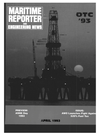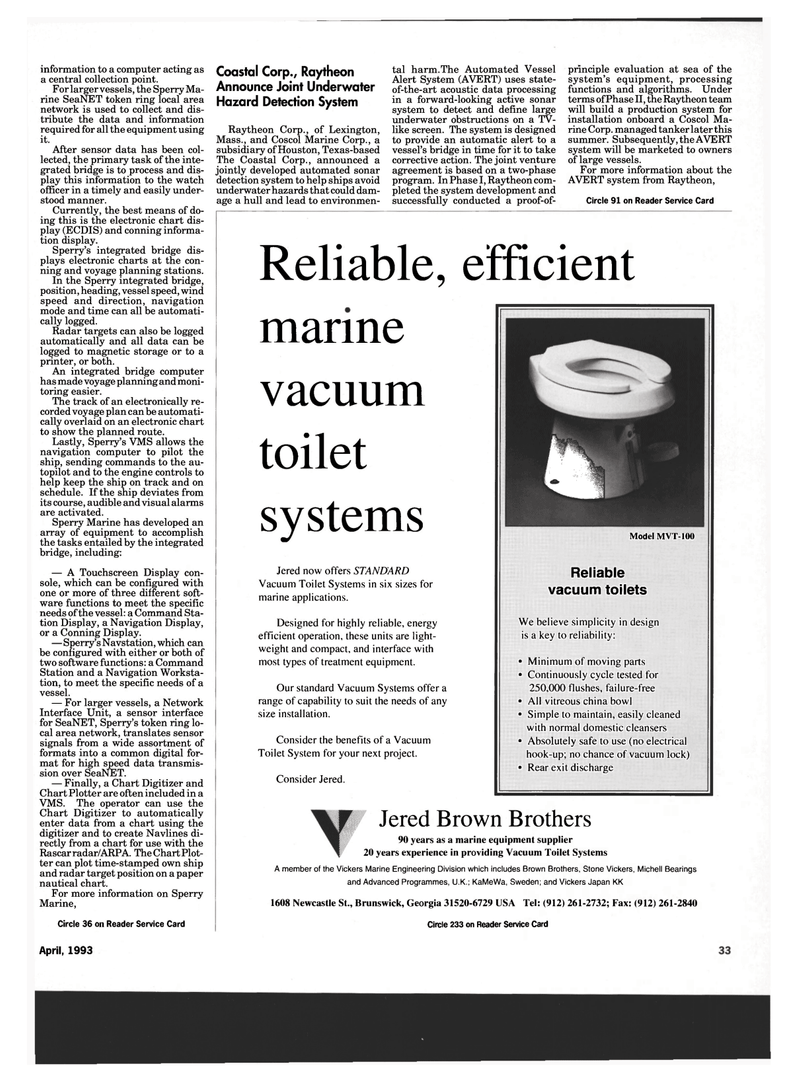
Page 31: of Maritime Reporter Magazine (April 1993)
Read this page in Pdf, Flash or Html5 edition of April 1993 Maritime Reporter Magazine
information to a computer acting as a central collection point.
For larger vessels, the Sperry Ma- rine SeaNET token ring local area network is used to collect and dis- tribute the data and information required for all the equipment using it.
After sensor data has been col- lected, the primary task of the inte- grated bridge is to process and dis- play this information to the watch officer in a timely and easily under- stood manner.
Currently, the best means of do- ing this is the electronic chart dis- play (ECDIS) and conning informa- tion display.
Sperry's integrated bridge dis- plays electronic charts at the con- ning and voyage planning stations.
In the Sperry integrated bridge, position, heading, vessel speed, wind speed and direction, navigation mode and time can all be automati- cally logged.
Radar targets can also be logged automatically and all data can be logged to magnetic storage or to a printer, or both.
An integrated bridge computer has made voyage planning and moni- toring easier.
The track of an electronically re- corded voyage plan can be automati- cally overlaid on an electronic chart to show the planned route.
Lastly, Sperry's VMS allows the navigation computer to pilot the ship, sending commands to the au- topilot and to the engine controls to help keep the ship on track and on schedule. If the ship deviates from its course, audible and visual alarms are activated.
Sperry Marine has developed an array of equipment to accomplish the tasks entailed by the integrated bridge, including: — A Touchscreen Display con- sole, which can be configured with one or more of three different soft- ware functions to meet the specific needs of the vessel: a Command Sta- tion Display, a Navigation Display, or a Conning Display. — Sperry's Navstation, which can be configured with either or both of two software functions: a Command
Station and a Navigation Worksta- tion, to meet the specific needs of a vessel. — For larger vessels, a Network
Interface Unit, a sensor interface for SeaNET, Sperry's token ring lo- cal area network, translates sensor signals from a wide assortment of formats into a common digital for- mat for high speed data transmis- sion over SeaNET. — Finally, a Chart Digitizer and
Chart Plotter are often included in a
VMS. The operator can use the
Chart Digitizer to automatically enter data from a chart using the digitizer and to create Navlines di- rectly from a chart for use with the
Rascarradar/ARPA. The Chart Plot- ter can plot time-stamped own ship and radar target position on a paper nautical chart.
For more information on Sperry
Marine,
Circle 36 on Reader Service Card
Coastal Corp., Raytheon
Announce Joint Underwater
Hazard Detection System
Raytheon Corp., of Lexington,
Mass., and Coscol Marine Corp., a subsidiary of Houston, Texas-based
The Coastal Corp., announced a jointly developed automated sonar detection system to help ships avoid underwater hazards that could dam- age a hull and lead to environmen- tal harm.The Automated Vessel
Alert System (AVERT) uses state- of-the-art acoustic data processing in a forward-looking active sonar system to detect and define large underwater obstructions on a TV- like screen. The system is designed to provide an automatic alert to a vessel's bridge in time for it to take corrective action. The joint venture agreement is based on a two-phase program. In Phase I, Raytheon com- pleted the system development and successfully conducted a proof-of- principle evaluation at sea of the system's equipment, processing functions and algorithms. Under terms of Phase II, the Raytheon team will build a production system for installation onboard a Coscol Ma- rine Corp. managed tanker later this summer. Subsequently, the AVERT system will be marketed to owners of large vessels.
For more information about the
AVERT system from Raytheon,
Circle 91 on Reader Service Card
Reliable, efficient marine vacuum toilet systems
Jered now offers STANDARD
Vacuum Toilet Systems in six sizes for marine applications.
Designed for highly reliable, energy efficient operation, these units are light- weight and compact, and interface with most types of treatment equipment.
Our standard Vacuum Systems offer a range of capability to suit the needs of any size installation.
Consider the benefits of a Vacuum
Toilet System for your next project.
Consider Jered. *
Model MVT-100
Reliable vacuum toilets
We believe simplicity in design is a key to reliability: • Minimum of moving parts • Continuously cycle tested for 250,000 flushes, failure-free • All vitreous china bowl • Simple to maintain, easily cleaned with normal domestic cleansers • Absolutely safe to use (no electrical hook-up; no chance of vacuum lock) • Rear exit discharge
Jered Brown Brothers 90 years as a marine equipment supplier 20 years experience in providing Vacuum Toilet Systems
A member of the Vickers Marine Engineering Division which includes Brown Brothers, Stone Vickers, Michell Bearings and Advanced Programmes, U.K.; KaMeWa, Sweden; and Vickers Japan KK 1608 Newcastle St., Brunswick, Georgia 31520-6729 USA Tel: (912) 261-2732; Fax: (912) 261-2840
Circle 233 on Reader Service Card
April, 1993 111

 30
30

 32
32
